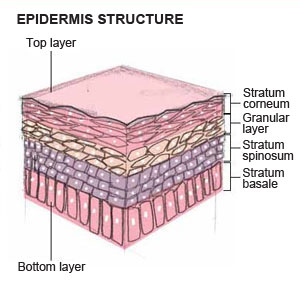這一陣子發貼回貼都不容易。大家這個時候還堅持討論,更不容易哈!
新的研究表明,絲聚蛋白在過敏性濕疹中扮演重要角色。很多過敏性濕疹的患者有絲聚蛋白基因的突變。這些突變使得絲聚蛋白數量減少或缺失,造成表皮層滲漏。這時水分容易散失造成皮膚幹燥,對過敏原的敏感性增加。
 |
 |

Normal skin (above left): In the granular layer of normal skin, the large profilaggrin protein is dephosphorylated and enzymatically cut into 10-12 smaller filaggrin molecules (1). As these cells move up to form the stratum corneum, they flatten their shape by collapsing their keratin structure—a process aided by interaction with filaggrin proteins (2). In the stratum corneum, filaggrin degrades into amino acids essential for maintaining moisture in the outer layers of skin (3). The intact skin barrier of healthy skin keeps allergens, pathogens (bacteria and viruses) and chemical irritants out of the body (4).
Eczema (above right): Mutations in the filaggrin gene greatly reduce the amount of filaggrin protein in the skin or lead to its complete absence (1), resulting in cracks in the skin barrier(2) that expose the lower layers to allergens that are usually kept out, thus causing eczema(3). Once foreign material, such as an allergen, passes through the defective skin barrier, it is spotted by cells of the immune system, leading to inflammation of the skin and other allergic responses (4). If a child is exposed to allergens through the skin, that exposure is more likely to prime the immune system to react aggressively to that allergen later in life, explaining the coincidence of asthma and eczema seen in patients throughout the world.
英文鏈接: http://www.the-scientist.com/?articles.view/articleNo/29383/title/The-Allergy-Gene/